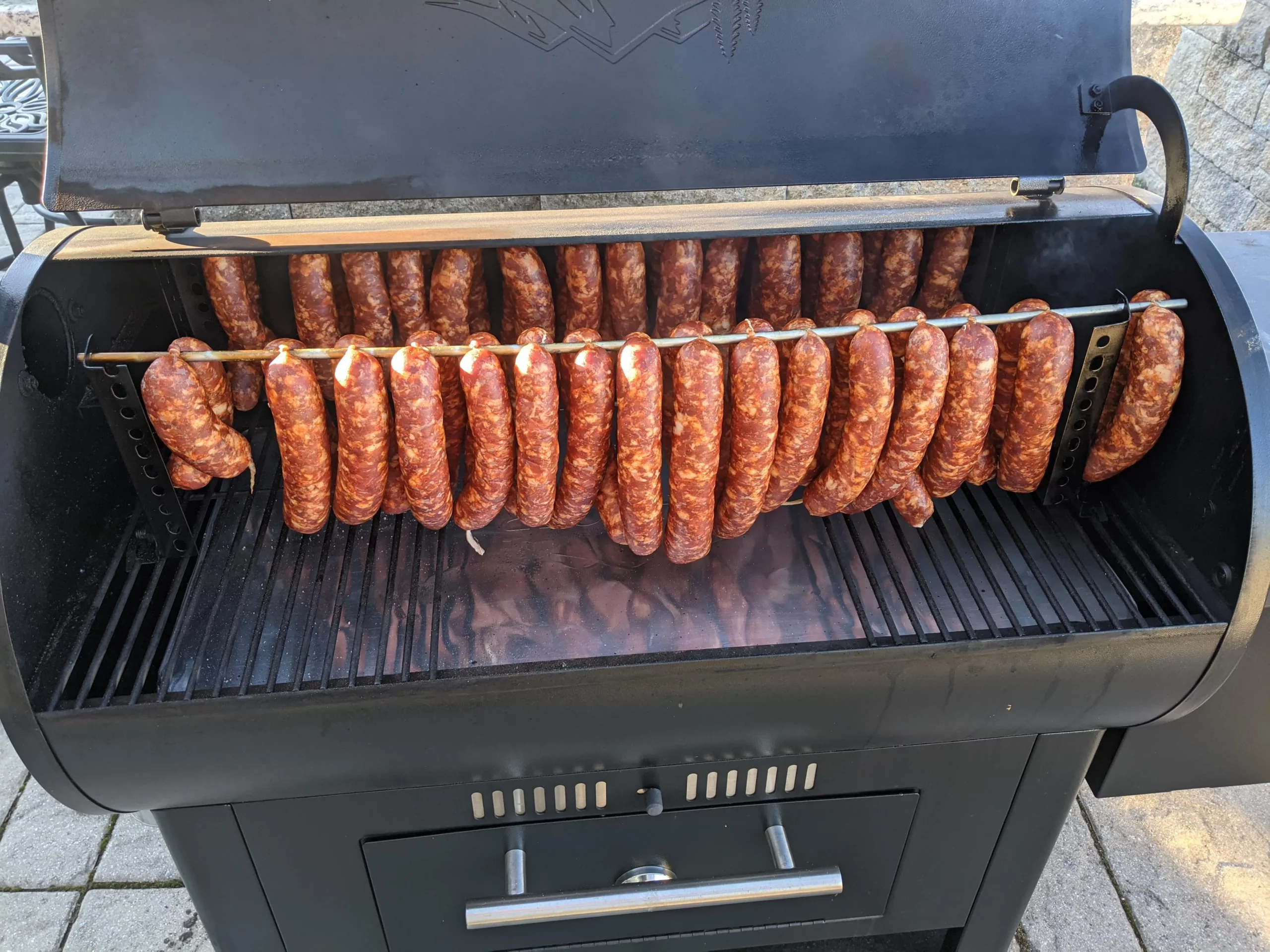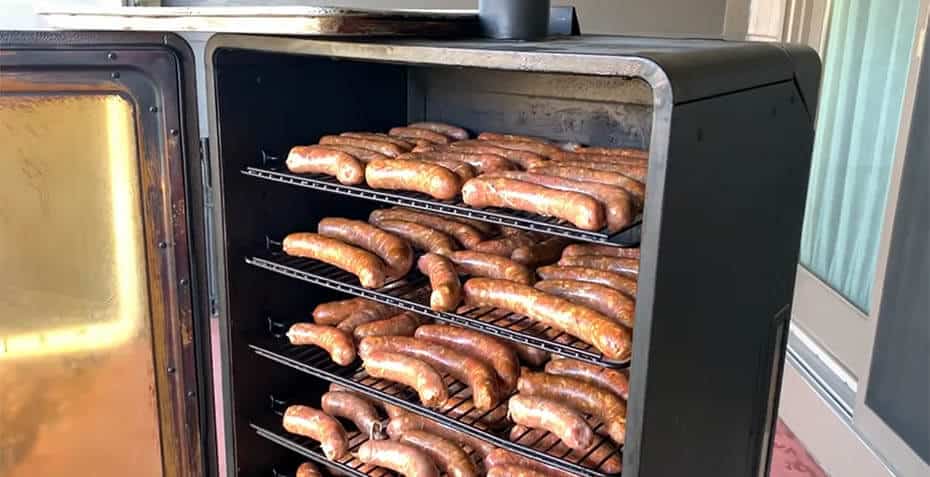Savor the Flavor: How to Make Mouthwatering Smoked Sausage at Home
Smoking sausages is a culinary art form that has been practiced for centuries. It is a method of preserving and flavoring meat that has stood the test of time. The process involves slow-cooking sausages over low heat and infusing them with the smoky flavors of wood. This not only enhances the taste of the sausages but also gives them a unique texture and aroma.
The history of smoking sausages can be traced back to ancient civilizations. It was a method used to preserve meat before the invention of refrigeration. By smoking sausages, people were able to extend their shelf life and enjoy them for longer periods of time. Over time, smoking sausages became more than just a preservation technique – it became an art form.
Smoking sausages is an art because it requires skill, patience, and attention to detail. It is not simply a matter of throwing sausages on a grill and cooking them until they are done. The process involves carefully selecting the right meat, preparing it with the right seasonings, choosing the right casings, and using the right smoking method and wood.
Each step in the process contributes to the final product, and each decision made along the way can affect the flavor and texture of the sausages.
Choosing the Right Meat for Your Sausage
When it comes to smoking sausages, choosing the right meat is crucial. The type of meat you use will greatly impact the flavor and texture of your sausages. There are several types of meat that are commonly used for making sausages, including pork, beef, chicken, and even game meats like venison.
When selecting meat for your sausages, it is important to choose high-quality cuts. Look for meat that is fresh, well-marbled, and free from any signs of spoilage. The quality of the meat will directly affect the taste and texture of your sausages, so it is worth investing in the best meat you can find.
In addition to the quality of the meat, the fat content and ratio are also important considerations. Fat plays a crucial role in the flavor and texture of sausages. It adds moisture and richness to the meat, and helps to bind the ingredients together. When making sausages, it is important to strike the right balance between lean meat and fat. Too much fat can make the sausages greasy, while too little fat can result in dry and tough sausages.
Preparing the Meat: Grinding, Mixing, and Seasoning
Once you have chosen the right meat for your sausages, the next step is to prepare it for smoking. This involves grinding the meat, mixing in seasonings and other ingredients, and ensuring that everything is well combined.
Grinding the meat is an important step in sausage making because it helps to create a uniform texture and ensures that all the ingredients are evenly distributed. You can use a meat grinder or a food processor to grind the meat, depending on your preference and equipment availability.
After grinding the meat, it is time to mix in the seasonings and other ingredients. This is where you can get creative and add your own personal touch to the sausages. Common seasonings for sausages include salt, pepper, garlic, paprika, and herbs like thyme or sage. You can also add other ingredients like onions, cheese, or even fruits for added flavor.
Proper mixing is crucial to ensure that all the ingredients are evenly distributed throughout the sausage mixture. This can be done by hand or using a stand mixer with a paddle attachment. The goal is to achieve a homogenous mixture that will bind together when cooked.
The Importance of Proper Casing for Sausage
The casing is an important component of sausages as it not only holds the meat mixture together but also contributes to the texture and flavor of the final product. There are several types of casings that can be used for sausages, including natural casings, collagen casings, and synthetic casings.
Natural casings, which are made from animal intestines, are the traditional choice for sausages. They have a natural elasticity and allow for better smoke penetration, resulting in a more authentic flavor and texture. Natural casings also have a slight “snap” when bitten into, which is highly desirable in sausages.
Collagen casings are made from the collagen found in animal hides and bones. They are more uniform in size and shape compared to natural casings, making them easier to work with. Collagen casings are also more resistant to breakage and can be used for both hot and cold smoking.
Synthetic casings are made from materials like cellulose or plastic. They are often used for commercial sausages as they are cost-effective and easy to use. However, they do not have the same natural qualities as natural or collagen casings and may not provide the same flavor or texture.
Before using casings, it is important to prepare them properly. Natural casings need to be soaked in water to remove any salt or preservatives. Collagen and synthetic casings usually come pre-soaked and ready to use.
Smoking Methods: Hot vs. Cold Smoking
There are two main methods of smoking sausages: hot smoking and cold smoking. Each method has its own advantages and is suited for different types of sausages.
Hot smoking involves cooking the sausages at a higher temperature, typically between 165°F (74°C) and 185°F (85°C). This method not only imparts a smoky flavor to the sausages but also fully cooks them, making them safe to eat. Hot smoking is ideal for sausages that are meant to be eaten immediately, as they are fully cooked and ready to serve.
Cold smoking, on the other hand, involves smoking the sausages at a lower temperature, typically between 68°F (20°C) and 86°F (30°C). This method does not fully cook the sausages but instead infuses them with a smoky flavor. Cold smoking is ideal for sausages that will be cooked or grilled later, as it allows for more flexibility in the cooking process.
The choice between hot and cold smoking depends on personal preference and the type of sausages being made. Hot smoking is more common and easier to achieve at home, while cold smoking requires more specialized equipment and techniques.
Selecting the Right Wood for Smoking Sausage
The type of wood you use for smoking sausages can greatly impact the flavor of the final product. Different types of wood impart different flavors and aromas to the sausages, so it is important to choose the right wood for your desired taste profile.
There are several types of wood that are commonly used for smoking sausages, including hickory, applewood, cherrywood, mesquite, and oak. Each type of wood has its own unique flavor profile and intensity.
Hickory is one of the most popular woods for smoking sausages. It has a strong, smoky flavor that pairs well with pork and beef sausages. Applewood and cherrywood have a milder, sweeter flavor that works well with poultry and game meats. Mesquite has a bold, intense flavor that is best suited for stronger-flavored sausages like chorizo or spicy Italian sausage. Oak has a more subtle flavor that can complement a wide range of sausages.
When choosing wood for smoking sausages, it is important to consider the intensity of the flavor you want to achieve. Stronger woods like hickory or mesquite can easily overpower the flavor of the sausages, while milder woods like applewood or cherrywood may not provide enough smokiness. It is also worth experimenting with different combinations of woods to create your own unique flavor profile.
Prepping Your Smoker: Temperature and Ventilation
Before you start smoking sausages, it is important to properly set up your smoker. This involves ensuring that the temperature and ventilation are properly controlled to achieve the desired results.
The ideal temperature for smoking sausages depends on the type of sausages being smoked and the method being used. For hot smoking, the temperature should be between 165°F (74°C) and 185°F (85°C) to fully cook the sausages. For cold smoking, the temperature should be between 68°F (20°C) and 86°F (30°C) to infuse the sausages with smoke without cooking them.
To maintain a consistent temperature in your smoker, it is important to monitor it closely. Use a reliable thermometer to measure the temperature inside the smoker and make adjustments as needed. Keep in mind that the temperature may fluctuate during the smoking process, so it is important to keep an eye on it and make any necessary adjustments.
Proper ventilation is also crucial for smoking sausages. It allows for the proper flow of smoke and helps to prevent the buildup of stale smoke or creosote on the sausages. Make sure that there is enough airflow in your smoker by adjusting the vents or dampers as needed. This will help to ensure that your sausages are evenly smoked and have a clean, smoky flavor.
The Smoking Process: Time and Temperature Guidelines
The smoking process for sausages requires time and patience. It is important to follow time and temperature guidelines to ensure that the sausages are properly cooked and smoked.
The time and temperature guidelines for smoking sausages can vary depending on the type of sausages being smoked and the method being used. For hot smoking, sausages should be cooked at a temperature between 165°F (74°C) and 185°F (85°C) until they reach an internal temperature of 160°F (71°C). This ensures that the sausages are fully cooked and safe to eat.
For cold smoking, sausages should be smoked at a temperature between 68°F (20°C) and 86°F (30°C) for several hours to infuse them with smoke. The exact smoking time will depend on personal preference and the desired level of smokiness.
It is important to monitor the temperature of the sausages during the smoking process to ensure that they are cooked and smoked evenly. Use a reliable meat thermometer to check the internal temperature of the sausages. Insert the thermometer into the thickest part of the sausage, making sure not to touch the bone or casing.
During the smoking process, it is important to be patient and resist the temptation to rush. Smoking sausages is a slow-cooking method that requires time for the flavors to develop and the smoke to penetrate the meat. It is worth waiting for the sausages to reach their full potential before enjoying them.
Tips for Achieving Perfectly Smoked Sausage
Achieving perfectly smoked sausages requires attention to detail and a few tips and tricks. Here are some tips to help you achieve the best results:
1. Use high-quality ingredients: Start with fresh, high-quality meat and seasonings for the best flavor and texture.
2. Keep everything cold: Cold ingredients are easier to work with and help prevent bacterial growth during the smoking process.
3. Don’t overmix the meat: Overmixing can result in a tough and rubbery texture. Mix the ingredients just until they are well combined.
4. Soak natural casings properly: Soak natural casings in water to remove any salt or preservatives before using them.
5. Experiment with different woods: Try different types of wood to create unique flavor profiles for your sausages.
6. Monitor temperature and smoke levels: Keep a close eye on the temperature and smoke levels in your smoker to ensure that the sausages are cooked and smoked evenly.
7. Be patient: Smoking sausages is a slow process that requires patience. Allow enough time for the flavors to develop and the smoke to penetrate the meat.
8. Avoid common mistakes: Avoid common mistakes like overcooking, undercooking, or using too much smoke, which can result in dry or bitter sausages.
9. Taste and adjust: Taste the sausages as you go and make any necessary adjustments to the seasoning or smoking process.
10. Practice and experiment: Smoking sausages is a skill that takes time to master. Practice and experiment with different techniques and flavors to find what works best for you.
Serving Suggestions: Pairing Smoked Sausage with Accompaniments
Once your sausages are perfectly smoked, it’s time to enjoy them! Smoked sausages can be served in a variety of ways and paired with different accompaniments to enhance their flavor.
One classic way to serve smoked sausages is on a bun with mustard and sauerkraut. This combination of flavors is a timeless favorite that brings out the smoky richness of the sausages. You can also serve smoked sausages with grilled onions and peppers for a flavorful twist.
Smoked sausages can also be sliced and used as an ingredient in other dishes. They can be added to pasta dishes, soups, stews, or even used as a pizza topping. The smoky flavor of the sausages adds depth and complexity to any dish.
When it comes to pairing smoked sausages with sides and beverages, there are endless possibilities. Smoked sausages pair well with a variety of sides, including potato salad, coleslaw, grilled vegetables, or baked beans. For beverages, consider serving smoked sausages with a cold beer, a glass of red wine, or even a refreshing lemonade.
The key to pairing smoked sausages with accompaniments is to choose flavors that complement and enhance the smoky richness of the sausages. Experiment with different combinations to find what works best for you.
Embrace the Art of Smoking Sausage at Home
Smoking sausages is not just a cooking technique – it is an art form that requires skill, patience, and attention to detail. By carefully selecting the right meat, preparing it properly, choosing the right casings, and using the right smoking method and wood, you can create sausages that are bursting with flavor and have a unique texture.
While smoking sausages may seem daunting at first, it is a skill that can be learned and mastered with practice. By following the tips and guidelines outlined in this article, you can achieve perfectly smoked sausages that will impress your family and friends.
So why not embrace the art of smoking sausages at home? With a little time and effort, you can enjoy the rich and smoky flavors of homemade sausages. Not only will you have full control over the ingredients and seasonings, but you can also experiment with different wood chips to add unique flavors to your sausages. Whether you prefer traditional flavors like hickory or want to try something more adventurous like applewood, the possibilities are endless. Plus, smoking sausages at home allows you to customize the level of smokiness to your liking, ensuring a perfectly balanced and delicious result every time. So why not elevate your culinary skills and embark on a flavorful journey by smoking sausages in the comfort of your own backyard?
Originally posted 2024-02-07 01:40:34.



